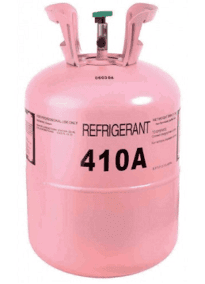R-410A was introduced way back in the early 1990s by Carrier corporation. But, it never really took off as an alternative Refrigerant until 2010. Why is that? Well, R-410A is the go to replacement product for R-22 Refrigerant.
R-22 was the standard refrigerant that was found in all home air conditioning units. If you had an AC unit it took R-22 that was all there was to it. The problem with R-22 is that it fell into the class of refrigerants known as CFCs. The CFC refrigerants are known to cause damage to the O-Zone layer which in turns modifies Earth’s environment… which is never good.
There was a treaty signed called the ‘Montreal Protocol,’ in the 20th century. One of this treaty’s goals was to eventually phase out of all of the O-Zone depleting CFC chemicals, refrigerants included. In 1994 R-12 Refrigerant was discontinued and replaced with the HFC R-134A.
The same thing happened with R-22 in 2010. In 2010 it was mandated by federal law that all new air conditioning machines would take R-410A Refrigerant instead of R-22. In 2015 the production of R-22 is going to be cut in half and in 2020 R-22 will be banned in the United States.
What’s Next for R-410A?

With all of the information I detailed above the future sounds great for R-410A. It is the primary refrigerant for all residential and commercial units now and all of the older R-22 units will eventually disappear as time wears on.
With that being said I am concerned about the R-410A’s future. Why you ask? Well, in September of 2014 the United States Federal Government announced that they are working on voluntary measures to phase out R-134A Refrigerant across the country. The government is pushing this not because of O-Zone depletion, which R-134A does not contribute, but because HFCs contribute to Global Warming. The measures are voluntarily at this stage, but they have set their sights on R-134A. I bring this up because R-134A is an HFC refrigerant. R-410A is also an HFC refrigerant.
At this point in time if nothing else changes I give R-134A another ten years of mainstream use before it is forced out by government regulation or mandates. So, it begs the question if R-410A’s close relative is going to be phased out what will happen to R-410A? It’s hard to say but I wouldn’t be surprised in the slighted that the next target is R-410A after they are done with R-134A. After all, it’s the same cycle all over again. In the 1990’s they went after the automotive refrigerant first then twenty years later they went after the residential/commercial refrigerant next. Looks like history is repeating itself…